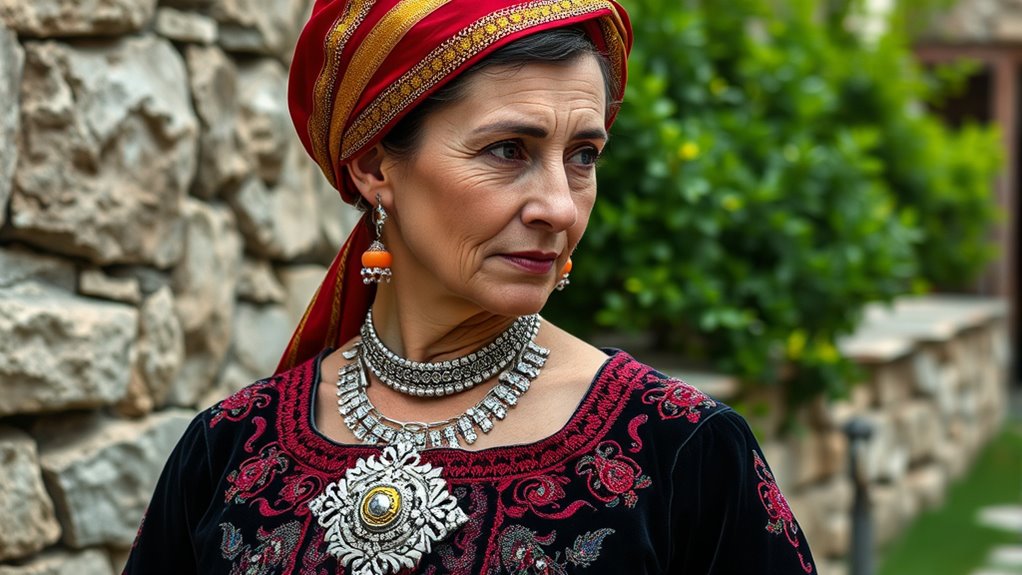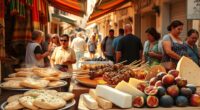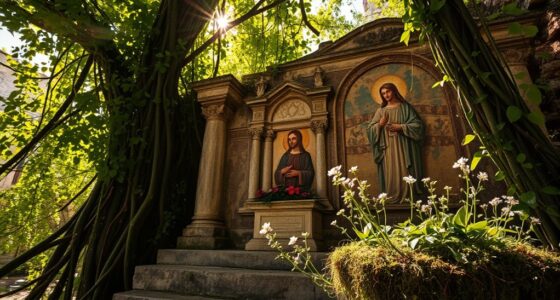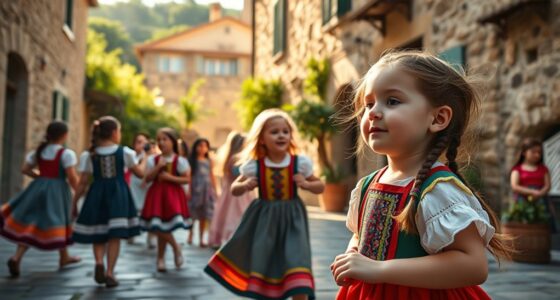Traditional Sardinian clothing reflects centuries of history, regional diversity, and cultural influences from Phoenician, Moorish, and Spanish periods. You’ll notice colorful embroidered dresses, elaborate jewelry, and symbolic headdresses that indicate social and marital status. Each region offers unique styles, made from wool, linen, silk, and hand-crafted ornaments. These costumes are essential during festivals and ceremonies, keeping local traditions alive. If you explore further, you’ll discover how Sardinia’s heritage continues to inspire contemporary fashion and preservation efforts.
Key Takeaways
- Sardinian traditional clothing reflects centuries of Phoenician, Moorish, Mediterranean, and Spanish influences, with regional variations across approximately 370 localities.
- Women’s attire is colorful and elaborate, featuring handcrafted embroidery, jewelry, and distinct headdresses indicating marital and social status.
- Fabrics such as orbace wool, silk, and linen are woven by hand, with natural dyes and motifs inspired by local natural elements and spiritual symbols.
- Costumes are used in festivals and ceremonies to symbolize fertility, prosperity, protection, and regional identity, often incorporating symbolic accessories and masks.
- Museums and cultural initiatives preserve and showcase authentic garments, while contemporary designers reinterpret traditional motifs in modern fashion.
Historical Roots and Cultural Influences

Have you ever wondered how Sardinian traditional clothing reflects its complex history? The roots of these costumes stretch back centuries, shaped by influences from the Phoenician era through Spanish rule. Between the 16th and 19th centuries, the current style emerged, transforming earlier dress forms. Sardinia’s position as a crossroads of Mediterranean cultures is evident in the costumes, blending Moorish, Mediterranean, and local traditions. Historical documents, including traveler accounts and illustrations from the 18th and 19th centuries, praise the richness and craftsmanship of these garments. By the late 19th century, traditional clothing began to fade, replaced by continental fashion. Today, these costumes serve as symbols of cultural identity, connecting Sardinians to their history and regional diversity. Preservation efforts and active participation in cultural festivals help keep these traditions alive for future generations. The regional variations in costumes highlight the diverse influences that have shaped Sardinia’s cultural landscape over centuries.
Materials and Techniques in Costume Craftsmanship
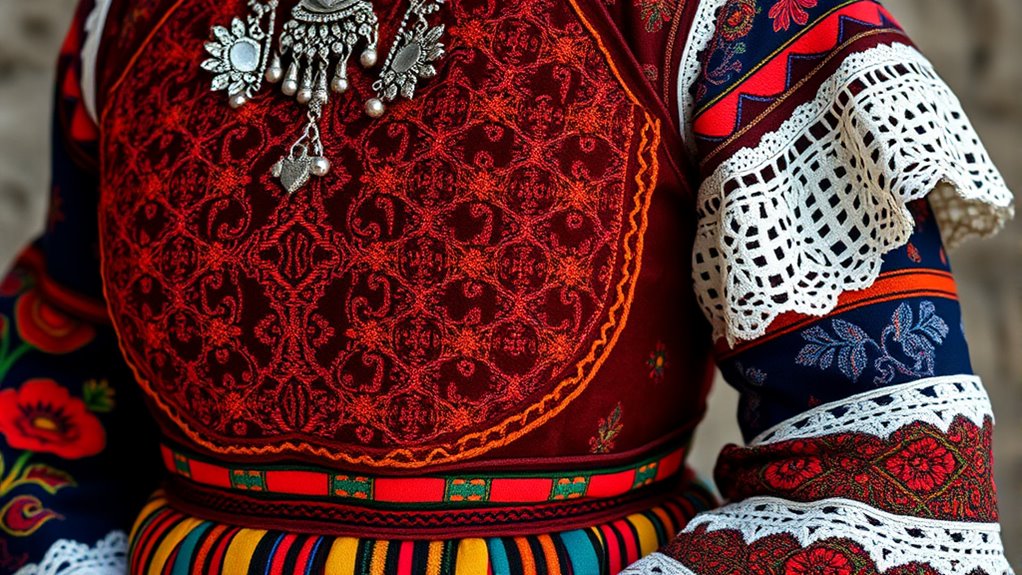
You’ll find that traditional Sardinian costumes rely on locally sourced fabrics like sheep’s wool, cotton, and linen, often woven by hand using ancient techniques. Handcrafted embroidery and detailed jewelry, such as filigree, add symbolic and decorative touches that highlight regional identity. These materials and techniques come together to create garments rich in cultural meaning and artisanal craftsmanship. The use of traditional tools and methods ensures that each piece maintains its authenticity and connection to Sardinian heritage, emphasizing the importance of textile craftsmanship in preserving these age-old traditions.
Traditional Fabric Choices
What materials do Sardinian artisans choose to craft their traditional costumes, and how do these materials reflect local resources and techniques? They primarily select wool from local sheep, especially orbace wool, which is combed, spun, and woven into waterproof, durable fabrics using traditional methods. This wool naturally comes in white and black, with shades like grey achieved through weaving or natural dyes. Plant fibers like flax, hemp, and cotton supplement wool, making lighter, breathable garments—cotton often forms the warp threads, while linen creates decorative raised patterns called pibiones. Orbace wool is obtained during the combing process from the longest, thickest sheep filaments, ensuring the quality and strength of the fabric. Artisan weaving is done on horizontal looms, with women maintaining these skills across generations. For special occasions, fine fabrics like velvet, brocade, and silk are used, highlighting craftsmanship and societal status in Sardinian culture, which is often expressed through intricate textile techniques.
Handcrafted Embroidery Techniques
Traditional Sardinian embroidery, particularly Punt ‘e Nù, relies on specific materials and precise techniques to create its distinctive textured patterns. You work primarily on high-count linen fabric, often homewoven, with white cotton pearl threads. The key stitch is the coral knot, worked mainly on vertical warp threads, often diagonally, to produce geometric, lacy designs. Proper tension and spacing are essential for consistency, as each knot’s size influences the pattern’s accuracy. You must carefully manage thread direction, whether moving left-to-right or right-to-left, to maintain pattern symmetry. Mastering this technique demands patience, dexterity, and attention to detail. The repetitive knotting creates textured motifs like pine leaves, hearts, and crosses, decorating men’s collars, cuffs, and yokes with precision and cultural significance. Additionally, understanding the materials used and their properties is crucial for preserving the authenticity and durability of the embroidery.
Jewelry and Ornamentation
Sardinian jewelry and ornamentation showcase a rich craftsmanship tradition that combines carefully selected materials with intricate techniques. You’ll find finely wrought gold and silver, prized for their durability and beauty, alongside local stones like obsidian and coral, which add symbolic meaning. Organic materials such as amber and wood connect the jewelry to natural elements and island heritage. Techniques like filigree, weaving delicate threads into lace-like patterns, and granulation, soldering tiny spheres for texture, create detailed, meaningful pieces. Symbols like wheat grains and protective talismans like su coccu reveal deep cultural values. You’ll notice:
- Use of gold and silver for strength and elegance
- Incorporation of local stones for symbolism
- Granulation representing fertility
- Artistic craftsmanship reflecting Sardinian identity
- The honeycomb technique, attributed to Janas, features small spheres and roses symbolizing abundance and love, combining ultra-fine filigree and granulation. Additionally, artisans often employ traditional methods passed down through generations, ensuring the preservation of these cultural techniques.
Symbolism and Meaning Behind Garments

The garments worn in Sardinian communities carry rich symbolic meanings that reveal much about social status, identity, and spiritual beliefs. For women, the “Sa Berritta” headdress indicates marital status, while different shapes and decorations mark age groups or special occasions. These headpieces often include symbols meant to invoke protection or blessings, linking personal attire to spiritual beliefs. Colors, materials, and embellishments like beads or embroidery also carry significance—representing fertility, prosperity, or regional identity. Embroidery patterns depict natural elements, daily life, or spiritual symbols, with specific colors indicating village affiliation or social rank. Jewelry and metalwork, such as amulets and ornaments, serve as protection and status symbols, embodying Sardinian heritage and personal virtues. Additionally, traditional craftsmanship ensures the intricate details and techniques preserve cultural authenticity and storytelling through garments. Altogether, garments tell stories beyond words, expressing community values and spiritual beliefs.
Regional Variations and Local Identity

Have you ever noticed how clothing styles across Sardinia vary so much from one region to another? This diversity reflects a profound sense of local identity. Each of the roughly 370 locations maintains unique costume traditions, with women’s attire often more colorful and elaborate than men’s, which tend to be simpler. Regional elements include different headdresses, bodices, skirts, and men’s garments like leather kilts or Spanish-influenced trousers.
- Unique headdresses, such as Villagrande Strisaili’s mini apron, symbolize local traditions.
- Materials like linen, silk orbace, and leather highlight regional resources.
- Coastal and inland areas showcase contrasting styles influenced by environment.
- Costumes serve as markers of social status, profession, and community pride.
- The variety of textiles and embroidery techniques used across regions demonstrates the regional craftsmanship and artistic heritage that define Sardinian dress. Additionally, cultural diversity is evident in the way each area incorporates distinct motifs and decorative patterns unique to their history and environment.
Festive and Ceremonial Attire
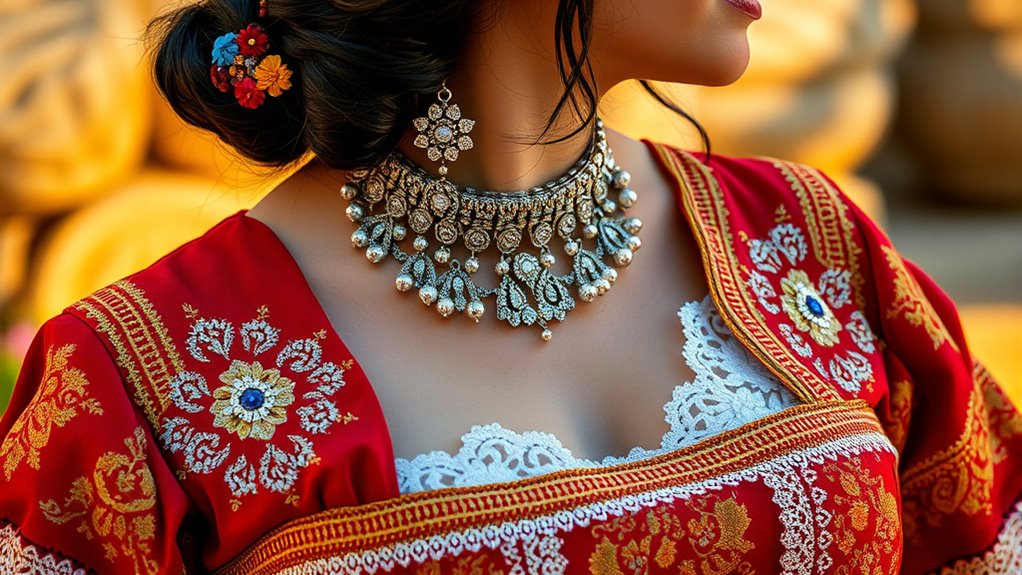
When you observe Sardinian festive and ceremonial attire, you’ll notice the intricate details that mark special occasions, from luxurious fabrics to symbolic accessories. These garments often feature specific embroidery, precious threads, and regional patterns that convey social and cultural meanings. Every element, including jewelry and decorations, plays a role in expressing identity, status, and the deep traditions behind Sardinian rituals. Additionally, these costumes often incorporate cultural heritage elements that highlight the island’s unique history and identity, demonstrating how fashion can serve as a form of cultural expression. Celebrated as an expression of faith, authenticity, and cultural heritage, these costumes reflect a rich history that has been carefully preserved and passed down through generations.
Festival-Specific Garment Details
Festival-specific Sardinian garments showcase vibrant regional variations that highlight local identity and social status. During festivals, each community displays unique costumes with specific embroidery, ribbons, and silver buttons—like the pink ribbon-laced bodice and oversized silver buttons from Ittiri. Men’s ceremonial outfits include short kilts, soft stocking caps, and wool fabrics, symbolizing tradition and masculinity. Women’s dresses are brightly colored, heavily embroidered, and made from local wool, linen, or imported silk, emphasizing community pride. These costumes often feature bright colors and ornate details influenced by Spanish and Moorish history, showcasing Sardinia’s rich cultural blend. Traditional clothing now is mainly worn during festivals and cultural events. Embroidery patterns indicate village and social rank. Ribbons and buttons reveal marital and economic status. Silver buttons and bright colors signify district identity. Traditional fabrics preserve regional craftsmanship and reflect regional textile traditions.
Jewelry and Accessory Significance
Jewelry and accessories play a pivotal role in Sardinian festive and ceremonial attire, serving both decorative and symbolic purposes. You’ll notice silver bracelets, crafted with traditional techniques, symbolizing cultural identity and featuring motifs like fertility and protection. Filigree jewelry, such as sphere-shaped buttons, represent fertility and prosperity, often given as gifts during special occasions. Wedding jewelry includes rings and breast-shaped buttons, symbolizing fidelity and abundance, while knives gifted to brides embody protection. These adornments aren’t just decoration—they carry emotional and spiritual meaning, reinforcing Sardinian heritage. The use of traditional jewelry is deeply rooted in Sardinian history, reflecting the island’s rich artisan craftsmanship and cultural symbolism. The intricate craftsmanship involved in creating filigree jewelry highlights the importance of preserving traditional techniques across generations. Here’s a quick look at common pieces:
| Jewelry Type | Symbolic Meaning | Common Materials |
|---|---|---|
| Silver bracelets | Protection, prosperity | Silver, engraved patterns |
| Filigree buttons | Fertility, life | Silver, obsidian, coral |
| Wedding rings & pins | Union, faithfulness | Silver, gold |
Ritual and Ceremonial Symbolism
Traditional Sardinian costumes are rich with symbolism that communicates cultural values and regional identities during important ceremonies and festivities. These outfits serve as powerful tools to convey meanings related to fertility, prosperity, and protection through specific ornaments and colors. During celebrations, the costumes reveal personal status and regional origins, acting as a visual language that preserves cultural diversity. Ceremonial attire plays a crucial role in events like weddings and religious festivals, reinforcing community bonds and heritage. The intricate embroidery and vibrant fabrics often depict motifs inspired by Sardinian mythology and local legends.
- The masks of Mamuthones and Issohadores symbolize the balance between good and evil, purity and darkness.
- Movements during ritual dances evoke ancient rites, aiming to ensure a bountiful harvest.
- Colors and materials reflect regional identities and agricultural traditions.
- Specific elements like buttons and masks carry symbolic meanings related to fertility and protection.
The Role of Jewelry and Accessories
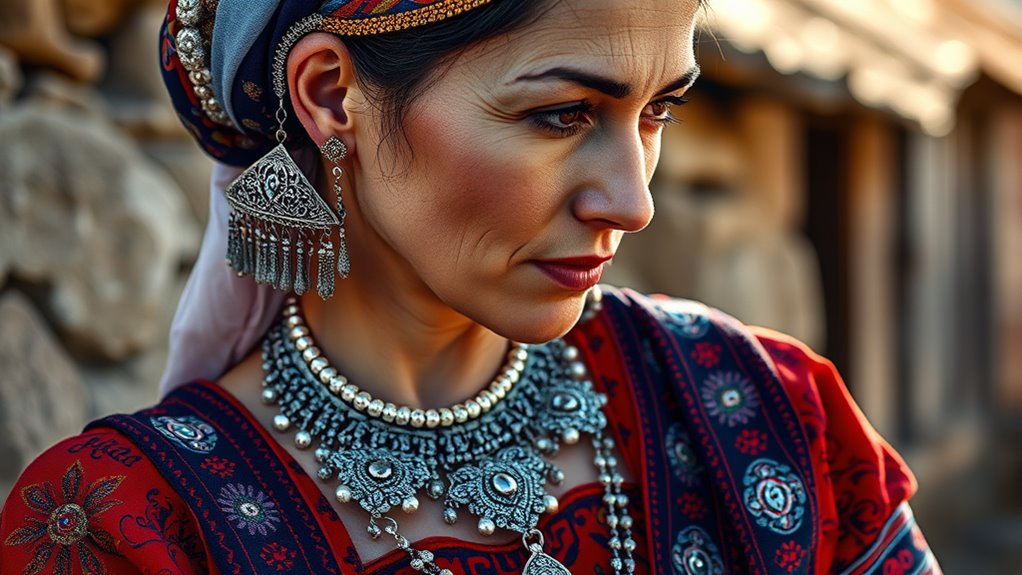
In Sardinian culture, jewelry and accessories serve much more than decorative purposes—they embody deep symbolic, protective, and social meanings. The *Su Coccu*, an ancient jewel crafted with black stone set in silver filigree, protects against negative energies and hexes. It also symbolizes fertility and life, echoing family values. Jewelry items like rings, such as the *maninfide*, symbolize love, union, and marital status, while pendants and earrings often feature motifs like crosses, suns, or zoomorphic figures, offering protection and cultural identity. Crafted from silver, gold, coral, and precious stones, these pieces showcase intricate artisan skills. Wearing specific jewelry signifies social standing, marital status, and regional origin, reinforcing collective identity and honoring Sardinian heritage.
Preservation and Museum Collections

Museums play a crucial role in showcasing Sardinian clothing through rotating exhibitions that protect delicate textiles from damage. These displays help keep traditional crafts alive and give you access to a diverse range of authentic garments and accessories. Behind the scenes, artisans and preservation initiatives work to safeguard these cultural treasures for future generations. They house about 8,000 items mostly from late 19th to early 20th century, ensuring the preservation of Sardinian material culture.
Museum Exhibitions and Displays
Preserving Sardinian clothing relies on dedicated museums that carefully curate and display authentic costumes, textile artifacts, and related crafts. These institutions showcase a wide range of regional attire, from everyday workwear to festive and religious garments, often displayed on life-size mannequins. Exhibits include rare funeral textiles, traditional jewelry, and textile crafts like saddle bags and towels, offering a broad view of Sardinian life. Museums enhance visitor understanding through multimedia presentations, such as films and photographs, and host temporary exhibits to highlight craftsmanship. They acquire garments directly from local families, ensuring authenticity. Guided tours and multilingual leaflets support engagement, helping visitors appreciate the cultural significance of Sardinian costumes and recognize the importance of preserving this heritage.
- Showcase regional diversity through costumes and artifacts
- Use multimedia to provide historical context
- Focus on both everyday and festive clothing
- Engage the public with educational programs
Artisan Preservation Initiatives
Artisan preservation initiatives in Sardinia actively strengthen the island’s cultural heritage by fostering collaborations between local craftsmen and fashion designers. These partnerships promote traditional textile crafts through sustainable collections, supporting local economies and livelihoods. Cooperatives use regional raw materials like Sardinian sheep’s wool and natural dyes, reintroducing fabrics such as orbace, linked to shepherd garments. Digital projects, like Bistìris, document costume variations, guaranteeing wider access and research. Workshops pass down skills in weaving, embroidery, and dyeing, blending tradition with modern sustainability. By reviving natural dyeing methods and eco-friendly practices, these initiatives conserve authenticity while appealing to contemporary markets. Their goal: safeguard Sardinian craftsmanship as a crucial cultural asset.
| Collaboration Focus | Cultural and Economic Impact |
|---|---|
| Traditional techniques | Revived through innovation and sustainability |
| Digital preservation | Ensures wider accessibility and research |
| Community workshops | Sustain skills and promote cultural continuity |
| Eco-conscious practices | Support regional identity and environmental health |
Contemporary Adaptations and Fashion Inspiration
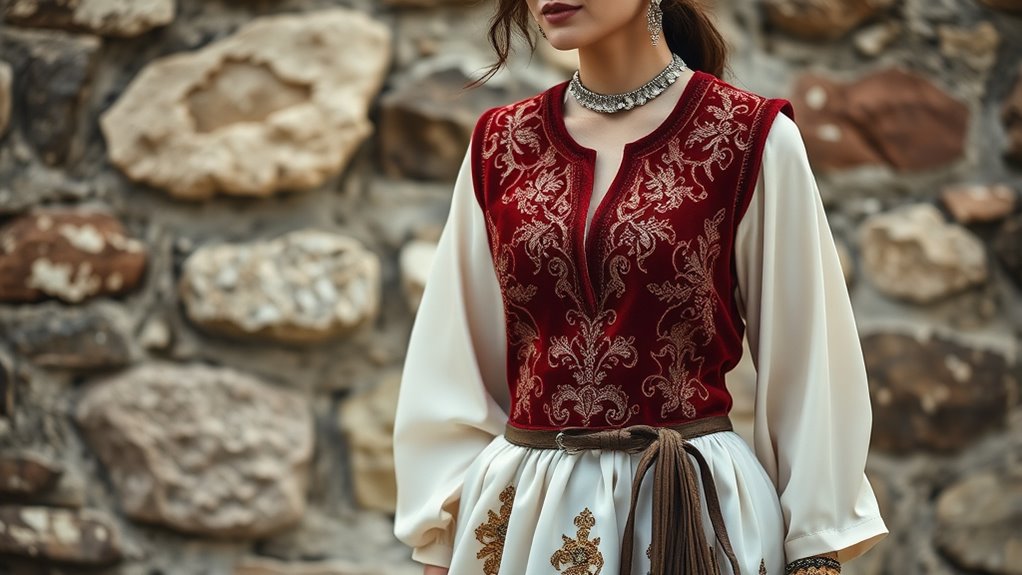
Contemporary Sardinian designers are creatively reinterpreting traditional motifs, blending ancient symbols and techniques with modern fashion trends. They craft garments and accessories that fuse Sardinian cultural heritage with high fashion, often using fabrics like velvet, brocade, and silk, enriched with embroidery and precious threads. Each piece varies depending on the region or village, influencing modern styles and adding depth to their designs. These unique creations have gained international recognition, spreading Sardinian refinement worldwide.
- They incorporate ancestral symbols into contemporary designs, creating meaningful fashion statements.
- Sustainability is key, with upcycling and zero-waste techniques reducing environmental impact.
- Collaborations with local farmers promote organic materials and ethical practices.
- Exhibitions showcase the dialogue between traditional costumes and modern fashion, elevating Sardinian textile art.
The Significance of Traditional Attire in Community Life
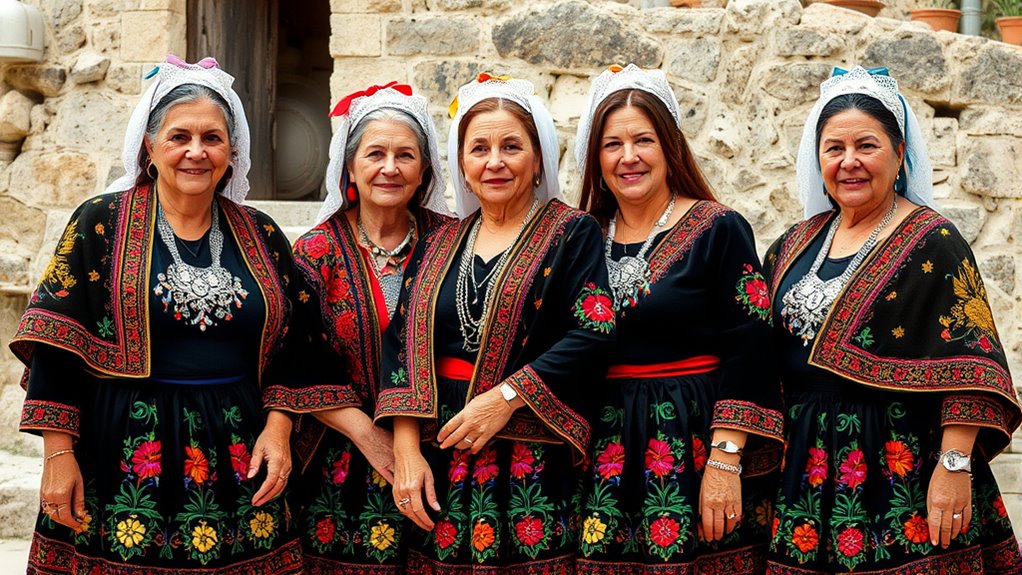
Traditional attire in Sardinian communities plays an essential role in expressing identity and fostering a sense of belonging. When you wear these costumes, you link yourself to a long history, showcasing your village’s unique traditions and values. Each community’s clothing acts as a “flag,” instilling pride and unity among residents. Different outfits mark occasions—everyday wear, festivals, or mourning—each with specific colors and styles that symbolize emotions and social roles. Donning these costumes during religious processions and celebrations transforms simple gatherings into vivid expressions of heritage. Fabrics, jewelry, and embroidery tell stories of local pride and craftsmanship. Sardinian costumes are also unique for their creativity and fantasy, which make each piece a work of art. By maintaining and wearing these traditional costumes, communities reinforce their cultural bonds and keep alive the distinct identities that define Sardinia’s rich mosaic.
Efforts to Sustain and Promote Sardinian Costume Heritage
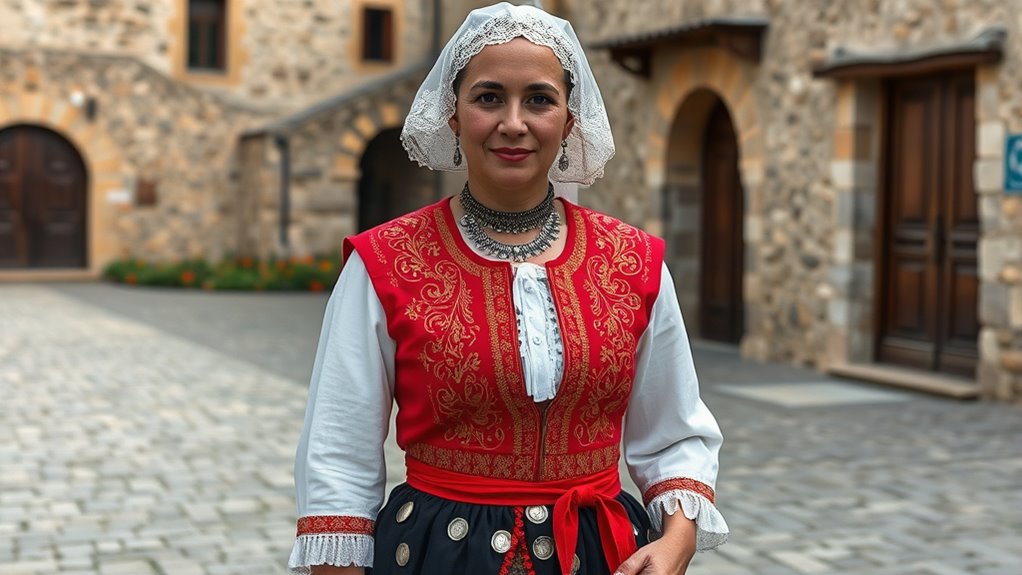
Efforts to preserve and promote Sardinian costume heritage have gained momentum through structured documentation, digital archiving, and active community engagement. The development of the Bistìris ontology creates a detailed framework for documenting regional styles and deviations, making heritage more accessible and understandable. Collaborations with institutions like the Sanna Museum and Nuoro’s Costume Museum help integrate expert knowledge and ensure accurate preservation. Additionally, artisan networks like the Sardinian Craftsmen Association promote traditional crafts through workshops, exhibitions, and education. Apprenticeships keep skills alive, while cultural events raise awareness. Innovators like Modolo Couture blend tradition with modern designs, attracting global interest. Museums serve as custodians, curating collections and offering educational programs that support both preservation and community revitalization.
- Digital frameworks enhance accessibility and scholarly research
- Artisan networks sustain traditional skills and boost local economies
- Innovation bridges ancient crafts with modern markets
- Museums foster education, community engagement, and cultural pride
Frequently Asked Questions
How Do Sardinian Costumes Vary Between Different Age Groups?
You notice how Sardinian costumes change with age. Younger women wear bright colors, lavish embroidery, and ornate head coverings, highlighting energy and youth. As you look at older women, their costumes shift to darker tones, simpler designs, and modest jewelry, reflecting maturity and respect. Men’s attire remains more consistent, but older men opt for more conservative versions. These variations help communicate age, social status, and cultural identity within the community.
What Specific Symbols Indicate Marital Status in Sardinian Attire?
Did you know over 400 regional costumes showcase Sardinian culture? When it comes to marital status, you’ll notice specific symbols like the Sa Berritta headdress, which varies for married and unmarried women. Embroidery patterns and jewelry also serve as clear indicators. These symbols are essential, revealing social roles and community ties, especially during festivals. They help you understand the rich traditions and the importance of social identity in Sardinian society.
Are There Modern Events Where Sardinian Costumes Are Still Worn?
You’ll find that Sardinian costumes are still vibrant in many modern events. For example, during the Sardinian Cavalcade in Sassari, over 3,000 participants wear traditional attire, showcasing regional culture through music, dance, and colorful costumes. Similarly, the Festival of Sant’Efisio in Cagliari features locals dressed in traditional clothing, celebrating heritage with processions and festivities. These events help keep Sardinian costume traditions alive and thriving today.
How Do Artisans Ensure Authenticity in Reproducing Traditional Costumes?
Think of artisans as guardians of a fragile flame, carefully keeping tradition alive. You guarantee authenticity by meticulously documenting original garments, embroidery, and jewelry from museums and community archives. You collaborate with elders and artisans, study regional variations, and use traditional materials like wool, linen, and natural dyes. Every stitch and detail follows strict guidelines, respecting rituals and regional differences, so the essence of Sardinian culture shines through, untouched by time.
Can Tourists Participate in Wearing Sardinian Traditional Clothing?
You often wonder if you can wear Sardinian traditional clothing during your visit. While most experiences focus on observing and learning, direct participation in dressing up is limited to museums, guided tours, or special workshops. You might not get to wear the costumes freely, but you can take photos or buy replicas. For a more immersive experience, plan ahead and look for curated events or workshops that offer tourist dressing opportunities.
Conclusion
As you explore Sardinian clothing, imagine it as a vibrant tapestry woven with history, tradition, and identity. Each stitch tells a story, and every garment is a thread connecting past and present. Embrace the rich cultural tapestry that these costumes represent, and recognize your role in helping keep this colorful heritage alive. Like a living mosaic, Sardinian attire continues to shine, reminding us that tradition is a precious piece of our collective soul.
